Sergeant Gander (3 page)

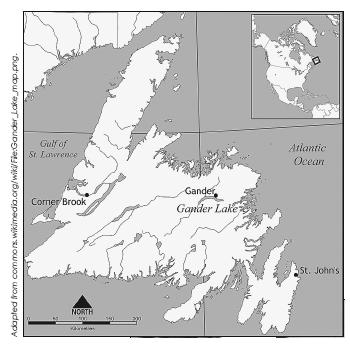
Location of Gander in Newfoundland.
From the time that Pal was a pup he became actively involved in the Canadian war effort. In 1940, the Dominion of Newfoundland gave operating control of Gander Airport to the Royal Canadian Air Force (RCAF). Renamed RCAF Station Gander in 1941, the airport became a hub of military activity as it was used not only as a disembarkation centre for pilots, but also for the transport of newly built aircraft from North America to the European war theatre. The airport was also a staging area for anti-submarine patrols. Pal was a familiar figure at the airport. When he was old enough he
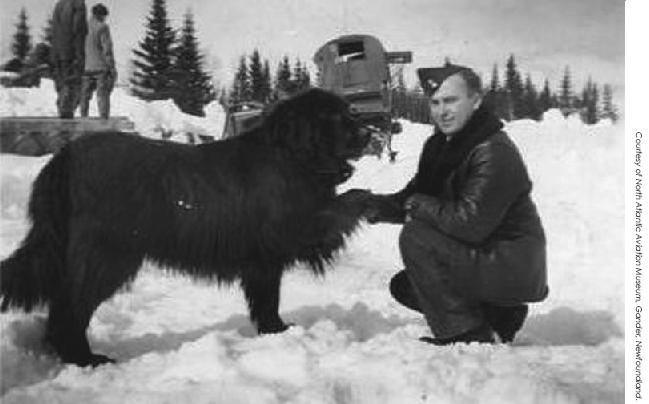
Gander/Pal with an unâidentified male friend, winter 1940.
was often put to work, harnessed to haul fifty-gallon drums of petrol, two at a time, from the warehouse to the airplanes to assist in the refuelling process. In fact, Pal is affectionately remembered as the first refuelling “vehicle” at the Gander airport.
When Pal wasn't working he enjoyed racing around the airfield and taking naps right on the landing strips. For pilots, the large dog presented a huge problem. He was so big and shaggy that many pilots radioed in that they couldn't land because there was a bear on the runway. Eileen Elms (formerly Chafe), a local Gander schoolgirl, remembers “Douglas Fraser, who landed the first plane here, did say he saw what he thought was a bear on the taxiway and it turned out to be Pal.”
6
A Brief History of Newfoundland and Labrador
The territory known as Newfoundland and Labrador is made up of the island of
Newfoundland and the area named Labrador, which is located on the continental
mainland of Canada. Newfoundland and Labrador are situated on the
northeastern side of North America, on the Atlantic Ocean. Originally populated
by indigenous people, Newfoundland was also home to several short-lived Viking
settlements as early as 986 AD. Rediscovered by the Europeans approximately five
hundred years later, it was first claimed for England by explorer John Cabot in
1497, and later by Sir Humphrey Gilbert in 1583. Newfoundland was a British
colony up until 1907, when it acquired self-government status and was renamed
the Dominion of Newfoundland.
Hit hard by the Great Depression of the late 1920s and early 1930s, the
Newfoundland government asked the British to take back control of Newfoundland
in 1934, until the Dominion could become more self-sustaining. Between 1934
and 1949 a six member Commission of Government was responsible for the
administration of Newfoundland, reporting directly to London. After the war
two referendums were held to determine the fate of Newfoundland. The first,
in 1946, was inconclusive, with 44.5 per cent of Newfoundlanders supporting
the restoration of Dominion status, 41.4 per cent supporting confederation with
Canada, and 14.3 per cent supporting the continuation of the Commission of
Government.
7
The second referendum, held in 1949, offered only two choices:
restoration of Dominion status or confederation with Canada. With fifty-two per
cent of the vote supporting Confederation, Newfoundland became Canada's tenth
province on March 31, 1949.
Canada and Newfoundâland showâing territorial boundaries as of 1941 (creâated in 1915).
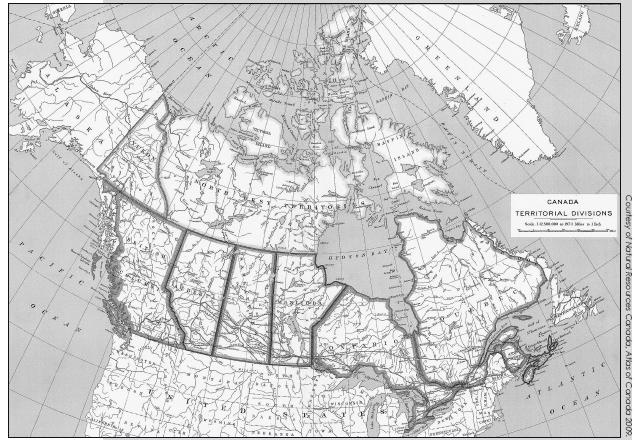
Gander Airport to 1945
Construction of the airport at Gander began in 1936, and it became operational two
years later. With four paved runways it was the world's largest airport at the time,
and was known as Newfoundland Airport.
In 1941, with the war raging in Europe and the German threat growing, the
Newfoundland government offered control of the airport to the Canadian government.
The strategic importance of this airport had caught the attention of both the Canadian
and Newfoundland governments. It was North America's most easterly land-based
airport, making it an ideal refuelling point for trans-Atlantic flights. Its location also
gave pilots the greatest range for surveillance flights over the western Atlantic Ocean.
However, there were fears that the airport, which had no active defence force, might fall
into the hands of the Germans. The Newfoundland governor, Sir Humphrey Walwyn,
requested that the facility be turned over to Canada for the duration of the war.
The Canadian government agreed and Royal Canadian Air Force (RCAF)
bombers arrived at the airport in June 1940, followed soon after by soldiers from
Canada's Black Watch, a reserve military unit from Montreal, Quebec. The Black
Watch regiment and the RCAF's orders were to defend the airport from air attacks
or sea-based landings, and to patrol the western Atlantic to provide early warning of
any enemy attack. The airport was renamed RCAF Gander, and expansion began
almost immediately with additional hangars, barracks, and storage being added
to the existing facility. The German threat to Canada's eastern coastline proved to
be very real. Not only did German submarines attack and sink Canadian ships,
penetrating as far as Rimouski on the St. Lawrence River, but the Germans also
laid mines in the waters off Halifax and St. John's and were able to establish an
automatic weather station in Northern Labrador.
By November 1940, Ferry Command, a Royal Air Force Service that had been
raised in status, was also operating out of RCAF Gander. Planes built in Canada
and the United States for Britain's Royal Air Force (RAF) were “ferried” or flown
across the Atlantic, as opposed to being dismantled and shipped by sea. This was a
much faster means of getting the aircraft to Britain and less hazardous as well,
since ships were always vulnerable to
Gereman U-boat attack.
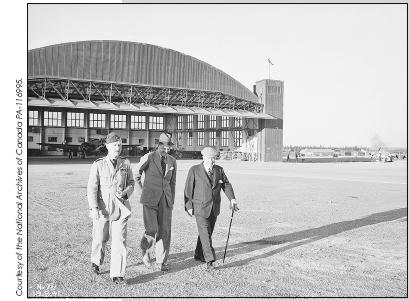
Photograph of Canadian Prime Minister Mackenzie King at Ganâder Airport, August 1941.
As the war progressed so did the
activity at RCAF Gander. By the
latter part of 1941, the air traffic
was so heavy that more barracks and
hangars had to be built, and the
runways were lengthened. Service
facilities like a bakery, a laundry,
and a hospital were added. Also in
1941, the Americans were invited
onto the base to assist in the war effort,
although they had not yet formally
entered the war. They stationed troops
there and added their own facilities
to the base, creating an “American
side.” By 1943, RCAF Gander was the largest air force base in Canada, playing
such an important role in Ferry Command that Britain's Prime Minister Winston
Churchill called RCAF Gander, “the largest aircraft carrier in the North Atlantic.”
8
At the end of the war many of the troops and materials returning from Europe were
also transported through the site.
RCAF Station Gander was disbanded in 1945, and control of the airport was
returned to Newfoundland.
Despite the difficulties that Pal caused for incoming pilots, his friendly nature made him an extremely popular figure at the airport. Adored by the neighbourhood children, Pal was their constant playmate. He loved playing with them too, and even allowed himself to be harnessed up to pull their sleds in the winter. Pal liked to run fast and he would race across the hardpacked snow with the sled bouncing along behind him. He wasn't very good at stopping though, and the ride usually ended with the children toppling off the sled. Eileen Elms fondly recalls, “He was very playful and gentle with us children ⦠and often knocked us in the snow ⦠we all loved him.”
9
Pal loved to greet people by rearing up and placing his paws on their shoulders. But one day he jumped up on a little girl, Joan Chafe, and accidentally scratched her face. The injury to the girl's face was actually quite severe. Joan's sister, Eileen, who witnessed the accident recalled that day: “I was one of the children who played daily with Pal ⦠A photo of Pal hangs on my living room wall. He's harnessed to a sled and I'm one of the three children being pulled by the dog ⦠One day during play the dog jumped on my sister's shoulders, but his paw missed and accidentally scratched her face.”
10
Eileen's sister had scratches in three places, and she remembers,
Photograph of Gander/ Pal pulling neighbourhood children Tom Hayden, Mike Ratcliffe, and Eileen Chafe.
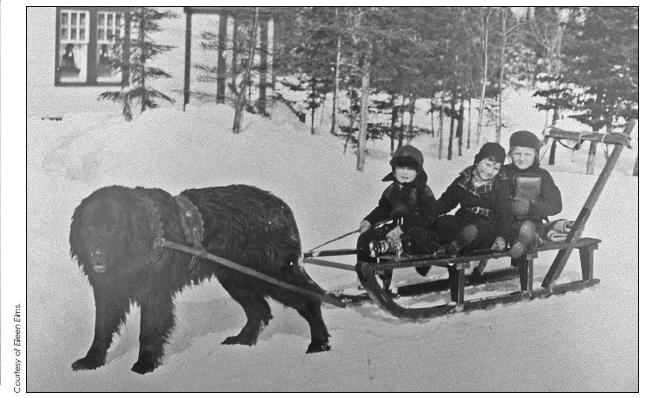
“There was lots of blood and both my mother and Mrs. Hayden were very upset ⦠my sister had the scars 'til she died as there was no doctor to stitch her face, and it didn't seem serious â nor was it really.”
11
Worried that Pal was becoming simply too big to be a family pet any longer, and that he was too much of a hazard to have running around the airfield, the Hayden family gave Pal to the Royal Rifles of Canada, an army regiment stationed at Gander Airport. The Royal Rifles, who had trained at Valcartier, Quebec, and who had previously been stationed in Sussex, New Brunswick, had arrived in Gander in November 1940. The majority of the Royal Rifles were stationed at Gander Airport while two companies were stationed at the Botwood seaport. The neighbourhood children were heartbroken, but the soldiers were ecstatic. The Royal Rifles renamed Pal “Gander,” and the big dog went from being a much loved family pet, to a much loved army mascot.
